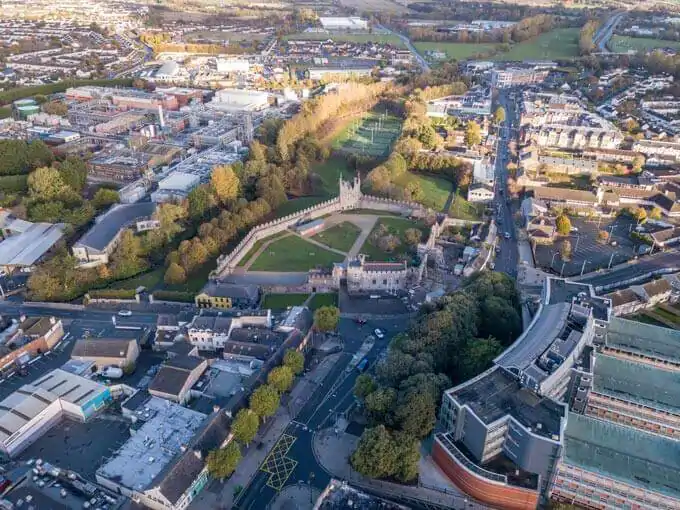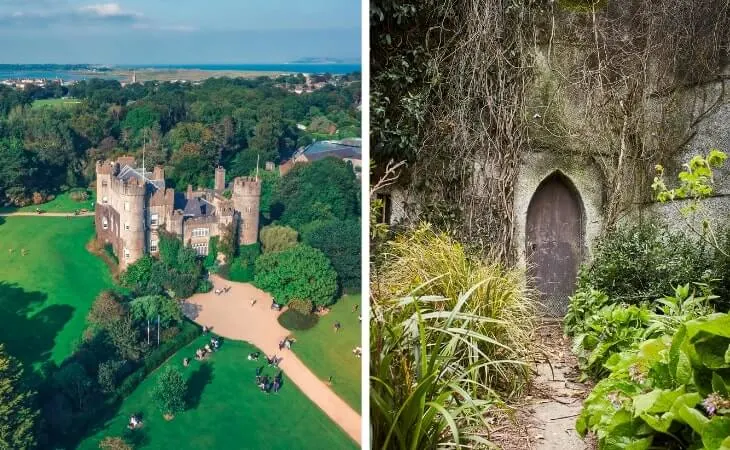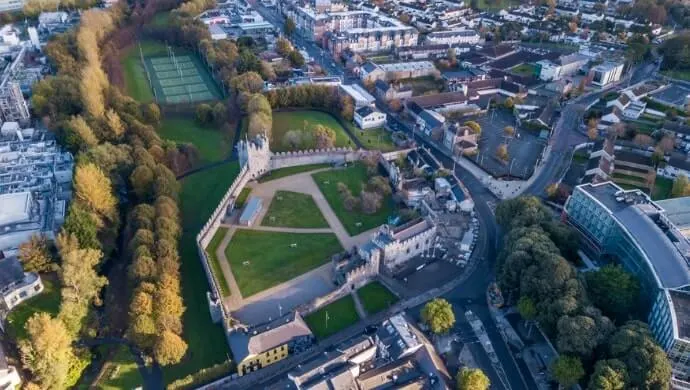The often-missed Swords Castle is one of the most overlooked castles in Dublin.
Swords Castle, located a 10-minute drive from Dublin Airport, is a national monument and the best surviving example of an archbishop’s palace in Ireland.
Here, you will find hundreds of years of history behind the walls. It is open to visitors all year round and tours are available on request.
Below, you’ll find info on everything from Swords Castle events and where to grab parking to what the future holds for it.
Some quick need-to-knows about Swords Castle

Photo by Irish Drone Photography (Shutterstock)
Although a visit to Swords Castle is fairly straightforward, there are a few need-to-knows that’ll make your visit that bit more enjoyable.
1. Location
Swords Castle is located in the ancient town of Swords – the county town of Fingal. It is about 10 kilometres east of Dublin city centre and is on the Ward River.
2. Parking
If you’re driving to Swords Castle, you can park on Swords Main Street (paid for parking) or at the Castle shopping centre (also paid). You can also park around at St Colmcille’s Church, which, again, is paid.
3. Opening hours and admission
The castle is open Tuesdays to Sundays from 9.30am to 5pm (4pm from October to February) and admission is free. Dogs are welcome in the park area but must be kept on a leash at all times.
4. A very hidden gem
Malahide Castle nearby receives hundreds of thousands of visitors every year and yet Swords Castle—a mere ten minutes from the airport—doesn’t get nearly as many. On the plus side, this means your visit is likely to be peaceful and you might find you have the whole place to yourself.
5. A bright future (…hopefully!)
Fingal County Council has embarked on a long-term plan to fully restore the castle and works are ongoing to turn the area into Swords Cultural Quarter. This has been in the works for a long time.
6. Weddings
Yes, you can get married at Swords Castle. It’ll cost you €500 and there’s a handful of things you need, but it’s possible. Info on booking here.
The history of Swords Castle

Photos by The Irish Road Trip
There was a monastic settlement in Swords from the 6th century attributed to St Columba (or Colmcille). In 1181, John Comyn became the local Archbishop and it seems that he chose Swords as his chief residence, possibly because of the wealth of the area.
It is thought the building of the castle (a manorial residence) began in 1200 and it appears to have been occupied by the successive Archbishops of Dublin until the early 14th century.
After that, the residence was abandoned and fell into disrepair, a likely impact of the damage sustained to the building during the Bruce campaign in Ireland in 1317.
Arachelogists suspect the castle may have been occupied again in the 15th century and that a constable occupied part of it during the 14th, 15th and 16th centuries. It was chosen as the rendezvous point for Irish-Catholic families during the 1641 rebellion.
In the 1930s, the site was put under the guardianship of the Office of Public Works and later purchased by Dublin City Council in 1985, later Fingal County Council.
Things to see at Swords Castle

Photos by The Irish Road Trip
There’s plenty to see and do at Swords Castle that make it well-worth a visit, especially if you’re only in Dublin for 24 hours and you’re staying in one of the hotels near Dublin Airport.
1. The chapel
Even for an archbishop’s residence, the chapel at Swords is unusually large. Since 1995, it has undergone extensive restoration and reconstruction, with a new roof added and new tiles made based on the ones found when the chapel was excavated in 1971.
New windows have been put in place and there’s a timber gallery that focuses on the traditional craftsmanship on the site.
During the excavation, archaeologists discovered a silver coin of Philip IV of France (1285-1314), which suggests the early 14th century date for the chapel’s construction. Archaeologists also found burial grounds outside the chapel.
2. The Constables Tower
The castle was fortified further during the 15th century, perhaps because of the ongoing Wars of the Roses in England. By the 1450s, irt was normal for archbishop’s manors to be surrounded by a curtain wall and protected by a tower.
The Constable Tower was restored between 1996 and 1998. A new roof was added, and the plank and timber beam floors were constructed from oak. The garderobe in the chambers is a chute that would take waste (i.e. sewage) out of the castle.
3. The gatehouse
A gatehouse was in place on site from the early 12th century when the constable William Galrote was reported to have been murdered at the gate of the court of Swords. Evidence shows that the present gatehouse was added to Swords Castle later on.
In 2014, excavations to stabilise the gatehouse wall found graves and a sunken structure beneath it—17 bodies of men, women and children were found. One of the burials was unusual – a woman buried face down with a token close to her right hand.
4. The Chamber Block
The Chamber Block has been reconstructed since 1995 and has a new roof, stairs, repaired walls and parapets. Originally, the block had three levels of accommodation.
The ground floor was for storage, then a set of wooden stairs on the outside led to a chamber, which might have been the visitors waiting area. At the top was the archbishop’s private chamber for him to entertain his guests.
5. The Knights & Squires
The Knights & Squires was originally a three-storey building, which went through several rebuilding stages. In 1326, an account described it as one chamber for the constable and four for knights and squires.
Under the chambers, there was a bakehouse, stable, dairy and carpenter’s workshop. Even in 1326, the account notes that Swords Castle wasn’t in good condition, though it may have been an attempt to downplay the archbishop’s wealth, as a formal inquisition into the person in position at the time also took place that year.
Things to do near Swords Castle
There’s plenty of things to do near the castle, from food in the town to some of Dublins top attractions which lay a short drive away.
Below, you’ll find everything from Malahide Castle and nearby beaches to one of our favourite walks in Dublin.
1. Food in the town

Photos via Pomodorino on FB
You’re spoilt for choice for places to eat in Swords. Whether you’re after traditional Irish pub grub, fancy a curry, pizza or Chinese, all options are covered. The Grill House offers Lebanese food, including chicken shawarma and calamari, while the Old School House Bar and Restaurant specialises in fish of the day, and Hogs and Heifers, American diner type dishes.
2. Malahide Castle

Photos via Shutterstock
Malahide Castle played a central part in Irish political and social life. It’s set on 260 acres of parkland, and there are some amazing picnic spots so you can make a day of your trip there. There are plenty of other things to do in Malahide while you’re there, too.
3. Newbridge House and Gardens

Photo by spectrumblue (Shutterstock)
Newbridge House and Gardens is Ireland’s only intact Georgian mansion. There’s the ‘Cabinet of Curiosities’; created in 1790, and it is one of the few remaining family museums left in Ireland and the UK. Nearby you’ll find Donabate Beach and Portrane Beach, too.

